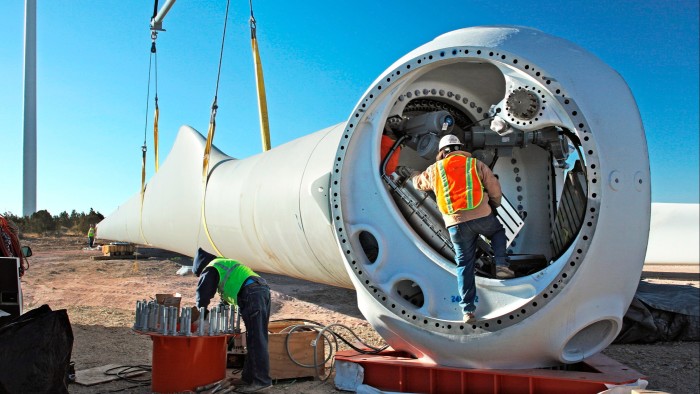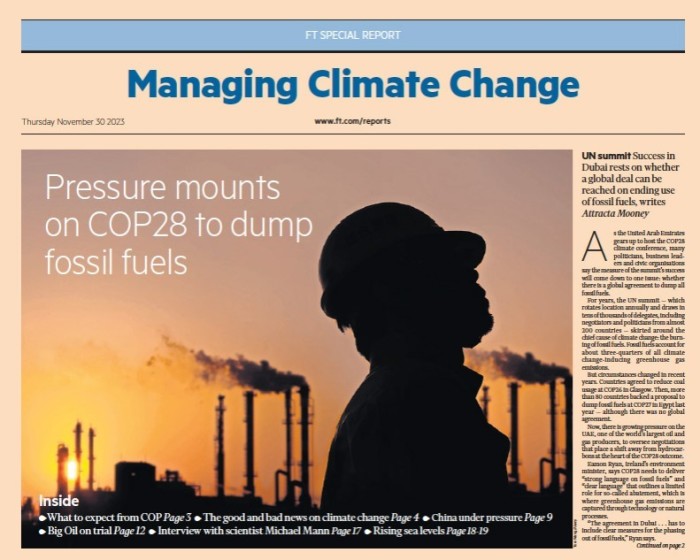Biden’s climate law triggers global shifts in cleantech supply chain

Simply sign up to the Climate change myFT Digest -- delivered directly to your inbox.
When US President Joe Biden passed his flagship climate law last year, he ushered the world into a new era of industrial policy.
The Inflation Reduction Act (IRA) marked the most significant legislative action the US has ever taken to reduce emissions, with $370bn in tax credits, grants and loans to rapidly decarbonise the world’s largest economy — while also building out a domestic supply chain for clean technologies.
Overnight, the US became one of the most attractive destinations for cleantech investment, much to the ire of the country’s trading partners, including the EU, which said the law had created “unfair competition”.
“Europe was probably in the lead if you had asked me 18 months ago, but now I think they’re playing catch-up,” says Fredrik Mowill, chief executive of Hystar, a Norwegian hydrogen company. Hystar is scouting sites for its first gigafactory in North America, a decision Mowill says was catalysed by the IRA.
The move by Hystar underscores the profound shifts under way in the global supply chain as a result of Biden’s climate law, with investors rushing to make historic commitments to manufacture in the US, and countries racing to protect their stake in the clean energy future. More than $200bn has been invested in US clean energy this year, a 37 per cent increase on the previous year, according to an analysis by think-tank Rhodium Group.

This article is part of an FT special report on Managing Climate Change
Many countries have since introduced competing incentives to counter the IRA and protect domestic industries. In March, the EU proposed the Net-Zero Industry Act, promising to speed up administrative timelines and allow member states to match incentives for projects at risk of going abroad.
Similarly, in its 2023 budget, Canada proposed C$20.9bn ($15.5bn) worth of incentives, including tax credits for clean electricity and hydrogen, as part of its Made in Canada plan, which cites the IRA as a “major challenge” to the country’s competitiveness.
“There’s a little bit of an arms race . . . between industrial nations. Nobody wants to lose their competitive edge,” says Chris Taylor, chief executive of GridStor, a US battery storage company. “Industrial policy is back at the forefront all over the globe.”
But sceptics question whether any country can compete with the size and might of the IRA, which analysts at banks such as Credit Suisse and Goldman Sachs predict could result in more than $1tn of federal spending because of the uncapped nature of its tax credits.
Its movement away from globalisation in a crucial decade for climate action has also sparked concern among analysts that a slower trajectory of emission reductions may result.
“There is a lot more that could be done in terms of developing low-carbon energy in the US if restrictions compelling or incentivising companies to use American-made products were abandoned,” says Ed Crooks, Americas vice-chair of consultancy Wood Mackenzie.
So far, the Biden administration has walked a tightrope as it tries to balance climate policy with domestic manufacturing within the IRA. Developers say its domestic content restrictions are too difficult to meet, while local manufacturers demand a stricter interpretation of a US-made product.
Andrés Gluski, chief executive of AES, one of the largest renewables developers in the world, says that, even with IRA tax credits, US restrictions on Chinese imports make the country a more expensive market for projects than Chile, for example, where solar panels are 50-80 per cent cheaper.
But he adds: “The US is such a big economy that there is a worry that it will suck up a lot of the equipment, a lot of the financing available — I’m not seeing that.” Gluski suggests the “most important part of the IRA” may be in its ability to deploy capital at nascent technologies and help commercialise new solutions.
Others question whether US-made products can be competitive with imports especially once the 10-year sweeteners in the IRA expire. China is the leading producer of clean technologies, making three-quarters of the world’s batteries and solar modules, and processing more than half of critical materials, such as cobalt and graphite. And a BloombergNEF report has warned that new US solar cell factories could become “functionally obsolete” in the next five years because of long timelines for construction and lack of competitiveness, compared with Asia.
The US clean energy buildout is also running into a tight labour market, a tough macroeconomic backdrop, and an outdated grid and permitting system. Nearly 90 per cent of construction companies are struggling to hire workers, according to Associated Builders and Contractors, a US industry lobbying group. Delays in tax credit rules and threats from the Republican party to roll back the IRA have further raised uncertainty for investors.
“How [the IRA] plays out is the thing that keeps us as investors awake at night, because the IRA is a fantastic front-end incentive to get factories built, but it does nothing to keep them solvent for the 30 years,” warned David Scaysbrook, co-founder of Quinbrook Infrastructure Partners, at the FT’s Investing in America summit on November 7. “There’ll be a great upfront sugar hit of new manufacturing capacity, and then you’re going to see a bunch of broken dreams,” he predicted.

Comments